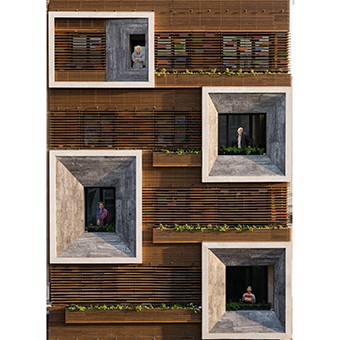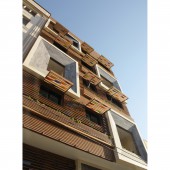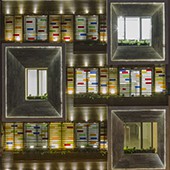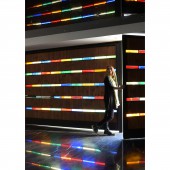
| THE AWARD |
| CATEGORIES |
| REGISTRATION |
| SUBMIT YOUR WORK |
| ENTRY INSTRUCTIONS |
| TERMS & CONDITIONS |
| PUBLICATIONS |
| DATES & FEES |
| METHODOLOGY |
| CONTACT |
| WINNERS |
| PRESS ROOM |
| GET INVOLVED |
| DESIGN PRIZE |
| DESIGN STORE |
| THE AWARD | JURY | CATEGORIES | REGISTRATION | PRESS | WINNERS | PUBLICATIONS | ENTRY INSTRUCTIONS |
Orsi Khaneh Residential Apartment by Nima Keivani |
Home > Winners > Design #46153 >Interview |
 |
|
FS: What is the main principle, idea and inspiration behind your design?
NK: The main concept of this built project originated from Iranian traditional architecture. They were using a special type of window which is locally called Orsi, made by wooden lattice and stained glasses, having had technical functions with regard to climate and natural light. Therefore we tried to make a modern Orsi window, with the aim of creating a space with an Iranian spirit or "genius loci" which respects both mental and biological needs of the users. Of course, the elements of Iranian architecture like water, plants, and light are highlighted in the project, in addition to the idea of Orsi.
FS: What has been your main focus in designing this work? Especially what did you want to achieve?
NK: As said, the main aim was to create a space with an Iranian spirit, so our target was to achieve a sort of modernized form of the elements of Iranian traditional architecture to create a architecture in which spatial qualities are improved in both physical and non-physical senses.
FS: What are your future plans for this award winning design?
NK: It's already been a successful built project.
FS: How long did it take you to design this particular concept?
NK: About two years: the building designed in June 2013 in Tehran and the construction works finished in September 2015 in Tehran.
FS: Why did you design this particular concept? Was this design commissioned or did you decide to pursuit an inspiration?
NK: We had a client who asked us to design this building for him. With his demands in mind, we thought that we can develop the idea and finally actualize it in this project.
FS: Is your design being produced or used by another company, or do you plan to sell or lease the production rights or do you intent to produce your work yourself?
NK: As said, we had a private client, Mr.Taheri.
FS: What made you design this particular type of work?
NK: An enthusiasm about the local architecture of Iran, and it's impressive atmosphere, created through manipulation of light and colors made us to use this sense for designing this residential project, "Orsi Khaneh".
FS: Where there any other designs and/or designers that helped the influence the design of your work?
NK: Particularly, our concept have been influenced by architecture of the old Iranian houses in Kashan/Iran.
FS: Who is the target customer for his design?
NK: As said, we had a private customer in this project, but looking at the type of the building, a residential apartment, we designed it for middle-class families of Tehran/ Iran.
FS: What sets this design apart from other similar or resembling concepts?
NK: The Orsi Khaneh's concept is unique at this time. In addition to our special view to traditional Iranian architecture, and trying to modernize the elements, we considered "Orsi" windows (traditional windows in Iranian architecture) as main theme of our design work. So in this work, we transformed it to a shell for the building.
FS: How did you come up with the name for this design? What does it mean?
NK: "Orsi Khaneh" adapted from "Orsi" which is the name of traditional windows of buildings: Wooden windows with stained glasses. And as the main concept of the building is Orsi window, We have called our project "Orsi khaneh" .
FS: Which design tools did you use when you were working on this project?
NK: Hand sketches and computer software like Auto CAD, 3Ds Max, Autodesk Revit.
FS: What is the most unique aspect of your design?
NK: As I said before, the formal and spiritual aspects are the most unique aspects. Creating a particular spatial quality through a special form is a unique approach in this project.
FS: Who did you collaborate with for this design? Did you work with people with technical / specialized skills?
NK: Architect in charge and Supervisor: Nima Keivani, Architect in charge: Sina Keivani, Client: Amir Abbas Taheri, Contractor: Mohammad Mashuf, Interior Design Associates: Ladan Mostofi , Plan Design Associates: Akbar Khalaj, Architectural theory consultant: Alireza Kharazmi Nezhad, Ideogram Developer: Maryam Sarshar, and Mechanical Consultant: Mehdi Bazargani
FS: What is the role of technology in this particular design?
NK: The facade of the building is a double layer coverage of Thermowood and stained glasses which in addition to its aesthetic aspect coming from lighting effects, has an effective role in controlling the temperature. Additionally there are intangible sunshades on this facade layer that easily can open upwards through a hydraulic jacks.The balconies are framed with boxes made up of travertine and are placed in such a way that the configuration implies a dynamic composition.
FS: Is your design influenced by data or analytical research in any way? What kind of research did you conduct for making this design?
NK: The main approach of research was to investigate the architecture of Iranian traditional houses. In this context, attempts were made to analyze special geometry, the role of vegetation, water, light, framing, Orsi windows and transparency in Iranian houses, along with measurement and attention to details using evidences on constructive experiences. According to the studies conducted before, it has been claimed that these traditional architecture have been a clear answer to the concept of Christian Norberg-Schulz, “Genius Loci”, in Persian architecture. Orsi window is practically analyzed as one of the main factors in this study. We analyzed its function and details and also effects on the residents using particular diagrams. So that there has been a creative speculations on the ways we can recreate a modernized form of Orsi, and then, a new Iranian “Genius Loci”. In fact, we conducted a research work and drew special diagrams and ideograms to discover the successful ways for using some elements of Persian architecture in an up-to-dated form in this building. So that, we focused on Orsi window and made it as a main idea in this building.
FS: What are some of the challenges you faced during the design/realization of your concept?
NK: Economic limitations, authorities and municipality potentially can be counted as strict limitations to a project. But we tried to use these factors as motivator to design and make the building with propitious, recyclable, and native materials. One of the challenges of the research was extracting the principles of Persian architecture and genius loci in residential spaces and transform it to a practical and modern language. Orsi window is studied as one of the main factors in our project.
FS: How did you decide to submit your design to an international design competition?
NK: After a successful attempt in the most credible architectural competition in Iran, we have decided to participate in an international competition.
FS: What did you learn or how did you improve yourself during the designing of this work?
NK: As a real project, we encountered with some of particular limitations and problems. To deal with these, we learnt how to solve the problems in our design process in order to make it a real product. There has been same process in construction works, as well.
FS: Any other things you would like to cover that have not been covered in these questions?
NK: We almost said everything about this project.
FS: Thank you for providing us with this opportunity to interview you.
A' Design Award and Competitions grants rights to press members and bloggers to use parts of this interview. This interview is provided as it is; DesignPRWire and A' Design Award and Competitions cannot be held responsible for the answers given by participating designers.
| SOCIAL |
| + Add to Likes / Favorites | Send to My Email | Comment | View Press-Release |




